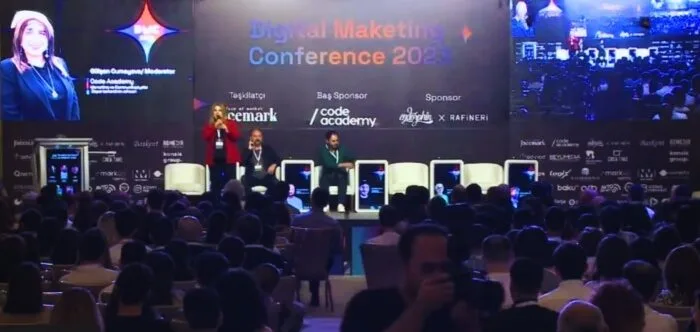Conference sponsorship is an invaluable opportunity for businesses to gain visibility, connect with their target audience, and promote their brand. However, the burning question that often arises is, “How do you measure the success of conference sponsorship?”
The solution lies in a strategic approach that involves tracking activities and analyzing data. Utilizing various tools such as surveys, polls, feedback forms, QR codes, landing pages, hashtags, and event apps can provide invaluable insights.
In this blog, we’ll dive into these methods, unraveling the secrets to effectively gauge the effectiveness of your conference sponsorship efforts. Stay with us as we guide you through the complications of measurement and help you unlock the full potential of your sponsorship initiatives.
What the Conference Sponsorship is About?
Sponsorship plays a huge role in making conferences successful. It provides financial support, enhances event quality, and creates opportunities for businesses to promote their brand. Sponsors help cover venue costs, speaker fees, and promotional activities. In return, they gain visibility and a chance to connect with potential clients, partners, or industry experts.
Companies, organizations, and even individual sponsors invest in conferences to build credibility and reach a larger audience. Depending on the sponsorship level, they might receive logo placements, speaking opportunities, or customized booths. This type of partnership benefits both parties, as sponsors gain recognition while the event receives the necessary resources to operate smoothly.
Many sponsorship packages offer different benefits based on contribution levels. Some provide simple logo placements, while others include VIP passes, networking access, or product showcases. Events often have multiple sponsors, each bringing unique value. Choosing the right sponsorship level allows businesses to maximize their impact while ensuring attendees receive a well-organized experience.
International events attract sponsors from various industries looking to expand their reach. In large-scale gatherings, like conferences in Canada, or USA sponsorship plays a key role in bringing together professionals, speakers, and organizations. These collaborations help improve event quality while giving businesses a valuable opportunity to engage with a global audience in a meaningful way.
How Does Conference Sponsorship Work?
A conference sponsorship is a mutually beneficial partnership where companies sponsor events for promos. Understanding how it works can be key to unlocking its potential for your business. The following is a detailed explanation:
Partnership Agreements
Conference sponsorship begins with a formal agreement between the sponsoring company and the event organizers. This contract outlines the terms, benefits, and obligations of both parties, ensuring a clear understanding of the partnership.
Financial Support
Sponsors provide vital financial backing to the event, helping cover expenses like venue rental, marketing, and logistics. This financial support is crucial for the event’s success and sustainability.
Promotional Opportunities
Sponsors enjoy a range of promotional perks, which may include logo placement on event materials, speaking slots during sessions, or branded exhibition spaces. These opportunities significantly boost brand exposure and recognition.
Targeted Audience Reach
Events attract a specific audience relevant to sponsors’ products or services. This focused demographic ensures that sponsor messages resonate with potential customers who are more likely to engage with the brand.
Engaging Attendees
Sponsors often go beyond traditional advertising by actively engaging attendees through product demos, giveaways, or interactive experiences. This interactive approach fosters direct connections and leaves a lasting impression.
Measuring ROI
Post-event, sponsors evaluate their return on investment (ROI) by tracking metrics like lead generation, brand awareness, and sales conversions. These insights help sponsors understand their conference sponsorship success goals and inform future sponsorship decisions.
Different Types of Conference Sponsorship
Conference sponsorship offers various avenues for businesses to showcase their support and gain exposure. Understanding these different types can help companies choose the most suitable sponsorship opportunity.
Title Sponsorship
Title sponsors hold the highest position and often have exclusive branding rights, prominently featuring their name in the event’s title. They enjoy extensive visibility throughout the event and are typically involved in event planning and decision-making. This level of sponsorship is ideal for businesses seeking maximum recognition and influence.
Exhibition Sponsorship
Sponsors can set up booths or exhibits to showcase their products or services, engaging directly with attendees. This type of sponsorship encourages face-to-face interaction, product demonstrations, and lead generation. It’s particularly beneficial for businesses looking to connect directly with potential clients.
Session or Workshop Sponsorship
Companies sponsor specific conference sessions or workshops, gaining recognition and often the chance to address attendees. This sponsorship type positions businesses as experts in their field and provides a platform to share valuable insights and knowledge, enhancing their reputation.
Networking Event Sponsorship
Sponsoring social or networking events allows businesses to foster connections and create a memorable experience for attendees. Whether it’s a cocktail reception or gala dinner, these opportunities facilitate relationship-building and positive brand association.
In-Kind Sponsorship
Instead of financial support, in-kind sponsors provide products or services needed for the conference, gaining exposure in return. This can include supplying event materials, catering, or technology services. In-kind sponsorship is a cost-effective way to participate in events.
Media or Promotional Sponsorship
Sponsors assist in promoting the event through marketing efforts or media exposure, enhancing its reach and visibility. This type of sponsorship is crucial for expanding the event’s audience and attracting more attendees.
How Do You Measure the Success of Conference Sponsorship?
Measuring the success of conference sponsorship is crucial for businesses to determine the impact of their investment. Here’s a step-by-step guide on how do you measure the success of conference sponsorship:
Step 1: Define Clear Objectives
Begin by setting specific, measurable goals for your sponsorship, such as lead generation, brand awareness, or product sales. Clear objectives will serve as benchmarks for success. For instance, if your goal is lead generation, specify how many leads you aim to generate during the event.
Step 2: Identify Key Metrics
Select relevant metrics aligned with your objectives. These may include the number of leads generated, website traffic, social media engagement, or attendee surveys. Choose metrics that directly reflect the success of your sponsorship goals.
Step 3: Pre-Event Baseline
Establish a baseline by collecting data on selected metrics before the conference. This will provide a point of comparison for post-event analysis. Knowing your starting point is essential to gauge the impact of your sponsorship accurately.
Step 4: Track During the Event
Utilize tools like QR codes, landing pages, and event apps to collect real-time data during the conference. Monitor attendee interactions, booth traffic, and social media mentions. These tools enable you to track engagement as it happens.
Step 5: Post-Event Data Collection
Continue gathering data after the event, including post-conference surveys, feedback forms, and website analytics. Compare this data to your pre-event baseline to assess changes and trends. This post-event data is crucial to accurately measure success of conference sponsorship and understand its long-term effects.
Step 6: Calculate ROI
Calculate the return on investment (ROI) by assessing the cost of sponsorship against the achieved results. Consider both the monetary value and the intangible benefits, such as increased brand reputation or partnerships formed. A positive ROI indicates a successful sponsorship.
Step 7: Analyze and Adjust
Analyze the collected data and assess whether your objectives were met. Identify areas for improvement and adjust your sponsorship strategy for future events based on these insights. Continuous evaluation and adaptation are key to maximizing the success of your conference sponsorships.
By following these steps, you can methodically measure the success of your conference sponsorship, ensuring that your investment delivers the desired outcomes and informs future sponsorship decisions.
Evaluating the Conference Sponsorship- How Does it Benefit You?
Conference sponsorships offer numerous benefits that can significantly improve your company’s growth and visibility. By evaluating these benefits, you can ensure that you maximize your investment and achieve your goals. Below are key ways conference sponsorship can benefit you:
- Enhanced Brand Visibility: Boost your brand’s presence by displaying your logo on event materials. Increased visibility leads to greater brand recognition among attendees.
- Targeted Audience Engagement: Interact directly with a focused demographic that matches your business interests. This direct engagement helps build strong customer relationships.
- Lead Generation Opportunities: Capture quality leads by engaging attendees at your booth or during sessions. These leads often convert into valuable customers.
- Product or Service Promotion: Showcase your offerings to an interested audience through demonstrations or presentations. Highlighting your products raise their appeal and marketability.
- Networking Advantages: Build connections with industry leaders, potential partners, and clients. These relationships can lead to future collaborations and growth opportunities.
- Market Insight Collection: Gain valuable insights into industry trends and competitor activities. Use this information to refine your business strategies and offerings.
- Positive Brand Association: Align your brand with a reputable event to increase its credibility. Positive associations foster trust and loyalty among attendees.
To maximize your investment, it is essential to thoroughly evaluate conference sponsorship and understand its benefits for your business growth.
FAQs About How Do You Measure the Success of Conference Sponsorship?
Measuring the success of conference sponsorship is essential for understanding the value of your investment and guiding future strategies. Below are frequently asked questions to help you effectively assess the impact of your sponsorship efforts.
What Are the Key Metrics for Evaluating Sponsorship Success?
Identify key metrics aligned with your objectives, such as lead generation, social media engagement, or website traffic. These metrics provide tangible evidence of your sponsorship’s effectiveness and help track progress toward your goals.
How Important Is Pre-Event Data Collection?
Pre-event data collection is crucial for establishing a baseline. By gathering data before the event, you can accurately measure the impact of your sponsorship and compare pre- and post-event performance.
Why Is Post-Event Analysis Critical?
The post-event analysis is vital for understanding long-term sponsorship impact. Collect and analyze data after the event to assess success, identify areas for improvement, and inform future sponsorship strategies.
How Can Feedback Forms Help in Measuring Sponsorship Impact?
Feedback forms provide direct insights from attendees, offering valuable data on their experience and engagement with your brand. Analyzing this feedback helps identify strengths and areas for improvement.
What Is the Importance of Analyzing Competitor Activities?
Analyzing competitor activities provides insights into industry trends and benchmarks for your sponsorship performance. Understanding their strategies helps you stay competitive and optimize your own sponsorship approach.
How Can You Assess the Long-Term Value of Your Sponsorship?
Assess long-term value by tracking ongoing engagement and conversions from leads generated during the event. Continued interactions and customer loyalty reflect the lasting impact of your sponsorship efforts.
Bottom Line
The success of conference sponsorships should be measured to ensure you get the best return on your investment. By setting clear objectives, identifying key metrics, and collecting pre- and post-event data, you can effectively gauge the impact of your sponsorship efforts. Using tools like surveys, feedback forms, and real-time tracking can provide valuable insight.
When addressing the question, “How do you measure the success of conference sponsorships?”, it’s necessary to analyze the data, calculate ROI, and make informed adjustments for future events. Ultimately, this strategic approach allows you to maximize sponsorship benefits, resulting in sustained brand visibility, lead generation, and long-term business growth.








